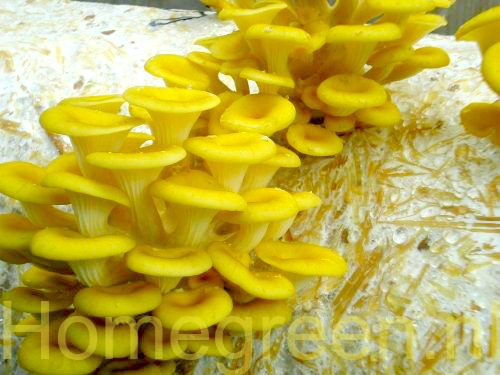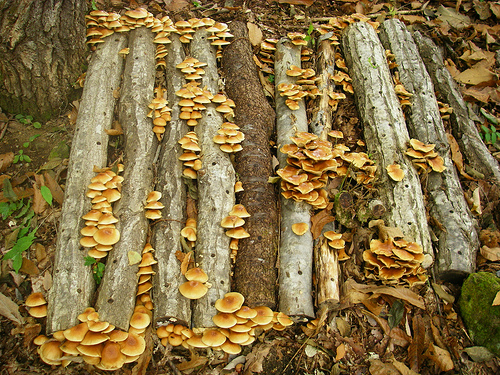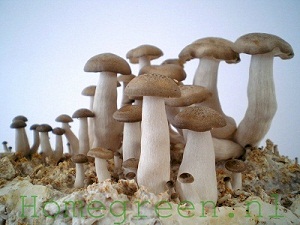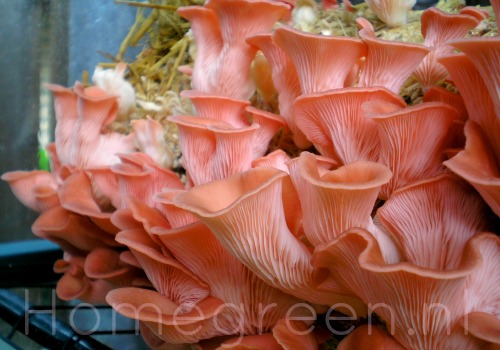Growing mushrooms in your garden
One of the easiest ways is growing on small logs using inoculated dowels.
Under sterile conditions (clean-room), the mycelium (spawn) of the appropriate species is grafted onto the dowels.
Once the dowels are completely covered with mycelium, we can use them to inoculate the logs.
Growing mushrooms on straw or wood chips is another easy way, more about this on the page 'Growing mushrooms on substrate'.


The mushroom is the fruiting body of a fungus. The fungus (mycelium) can be compared to a root system. It takes nutrients from the environment, allowing the fungus to grow.
The different types each have their own nutrition preferences.
Some species, such as the oyster mushroom, are less picky. While shiitake has a preference for oak, the mushroom feels best in fertilized soil.
And then there are species that live in symbiosis with a certain tree, but those are less interesting to us.
The species we're talking about here, grow on wood that is dead or nearly dead. The mushroom helps in the digestion process. The wood is converted into substances that are better absorbed by the soil, which further decays to humus.


Since we can't drag home a whole tree, we take a saw and go for a walk, preferably into a foresty area. Once we get there, we take a good look around and find the tree that our mushroom likes best. And since we're looking around anyway, keep an eye out for the forester.
Stems that are easy to cut and carry, are preferred.
Small logs are grown through quicker than large ones, but don't pick too thin ones, because those dry out sooner. From a diameter of 15 cm is fine.
Most fungi like hardwoods, such as beech, hazel, chestnut, maple, poplar, birch, etc. So no conifers such as pines and firs. Conifers contain a natural anti-fungus, that protects the tree against ...fungi. This includes mycelium. Some species do grow on softwood.
Fruit trees are also unsuitable, as they contain certain gums that fungus will not grow on.
Shiitake prefers oak. This tree too contains a substance (tannin) that's not edible for the mycelium of some species, but which the shiitake can handle well. This is the shiitake's advantage over other fungi, but it also grows on other types of hardwood.
But … ok, we're freezing our butts off in the woods, so to make it easier, the species we want to grow, grown on beech, hazel, chestnut, maple, birch etc.
Which mushroom species and trees best fit together, you can read in the individual species description.
Inoculating logs can be done year round, but it's better to avoid freezing. For the first 2 weeks after inoculation, protect the logs from frost.
Do not take wood that has been lying there for some time already, as it will already be grown through with other fungi.
Best is a newly fallen tree (with respect for nature and the forester).
We're only sawing fresh logs, so we have to let them dry first, (about one month). Certainly no longer than three months, or else other (unwanted) fungi may take their chance.
By the time we have received the ordered dowels, the logs will be ready, and if not, we wait a little longer.
The dowels can be kept in the fridge for another couple of weeks, but the fresher they are, the better.
Next drill holes in the log, spacing them about 15 to 20 cm from each other, and the dowels can be forced in with a hammer. The dowels shouldn't stick out. Note that the mycelium prefers to grow with the grain of the wood, so make sure to stagger the location of the holes. See picture 1.

The amount of dowels that are put in a log, determines the speed with which the mycelium will cover the whole log.
More dowels will make the log be covered in mycelium faster, and limits the possibility for other fungi to get a chance.
Oyster mushroom mycelium grows faster than Shiitake mycelium and thus need fewer dowels with the same result.
For all species we need a minimum of 30 dowels for 100 cm long log with a 15 cm diameter.
The best size drill, is one that's about 0.5 or 1 mm bigger than the dowel, but make sure the hole will not be too wide. The dowel should not have any wiggle room. If you don't have a special drill for wet wood, make sure to hold the drill firmly. The drill has a tendency to be drawn into the wood. For the dowels we sell, use a 9 mm drill.
Then close the holes with wax. Just melt an old candle in a small pan, and use a brush to rub the wax over the dowels in the holes. You can also use cheese wax or beeswax.
This is against dehydration and insect damage.
Look at this YOU TUBE instruction video's
We now put the logs in a shady spot in the garden, see figure 2, possibly covered with some leaves or grass and watering them only in very dry weather. Let nature do the rest.
On the balcony is also possible, but we must keep an eye on the right level of moisture. For example in a container with moist sand.
For more information go to "Cultivation on logs".
Now our patience will be tested, because it can take anywhere between a couple of months and 2 years before the logs are fully grown through. Especially the harder woods such as oak and beech need more time. But once those are grown through, they can last for as long as 5 years.
The appearance of a group of mushrooms, is called a flush. This often happens after a heavy rainfall or a sudden drop in temperature.
The combination of shiitake on oak is ideal, takes the longest, but also last longest.
Oyster mushroom is a fast grower and in combination with for example willow, poplar or birch, gives fairly quick results.
Shiitake often starts to form fruiting bodies after a cold period. This species can also be 'shocked' by immersing the logs in cold water for 24 hours. The flush will follow after this.
Do this only after they are fully grown through. This can often be seen at the ends of the trunk, the mycelium is clearly visible then.

